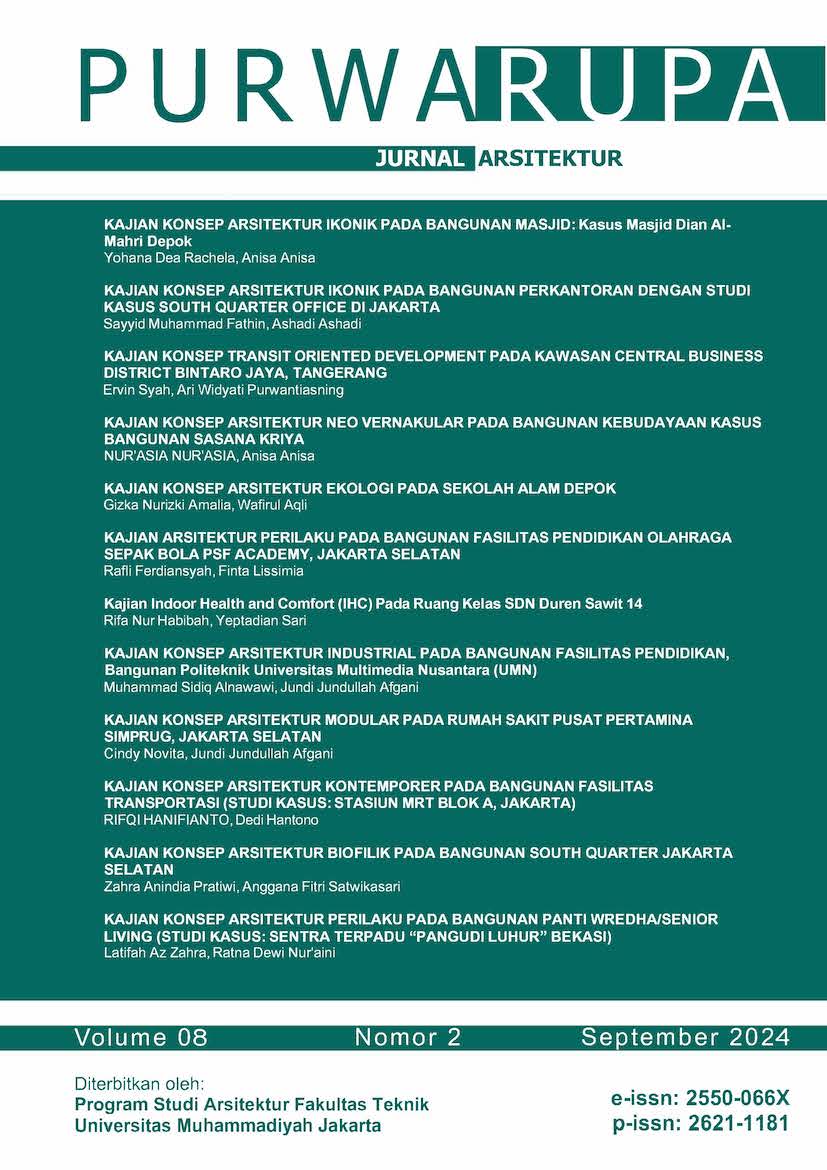KAJIAN KONSEP ARSITEKTUR KONTEMPORER PADA BANGUNAN FASILITAS TRANSPORTASI (STUDI KASUS: STASIUN MRT BLOK A, JAKARTA)
DOI:
https://doi.org/10.24853/purwarupa.8.2.161-168Abstract
ABSTRAK. Infrastruktur transportasi memegang peranan penting sebagai sarana pergerakan orang dan barang. Infrastruktur transportasi kereta api menjadi solusi permasalahan kemacetan jalan, dimana jumlah kendaraan setiap tahunnya menjadi permasalahan di Indonesia. Kereta api merupakan salah satu alat transportasi jalan raya yang memiliki keunggulan dibandingkan alat transportasi jalan lainnya. Kereta api merupakan metode pengangkutan penumpang dan barang dalam jumlah besar dengan banyak keuntungan: menghemat lahan, menghemat energi, dan mengurangi polusi juga meimiliki jam yang dapat di andalkan. Saat ini stasiun – stasiun kereta api di seluruh Indonesia merupakan bangunan peninggalan zaman penjajahan. Untuk memfasilitasi penumpang dengan baik dan dengan melonjaknya jumlah pengguna kereta api setiap tahunnya. stasiun kereta api kedepannya akan menerapkan konsep desain arsitektur kontemporer agar tampilan dan ruang yang dihasilkan menjadi unik dan inovatif serta, apalagi jika stasiun tersebut berada di Tengah kota yang modern. Arsitektur kontempoer juga dapat menghadirkan keterbukaan antara bangunan dan lingkungan disekitarnya karena itu menjadi ciri khas arsitektur kontemporer. Penelitian ini bertujuan untuk menjawab permasalahn yang timbul pada bangunan kereta api yang dimana bangunan kereta api di Indonesia masih menggunakan bangunan lama yang dibangun pada masa kolonial. Dimana bangunan stasiun terkadang masih tidak serupa dengan bangunan di disekitarnya terutama dikota besar yang dimana bangunan disekitarnya merupakan bangunan modern dan ikonik. Penerapan Arsitektur kontempoerer pada bangunan stasiun dapat menjawab bagaimana stasiun kereta dapat dibangunan dengan konsep arsitektur kontemporer pada Kawasan kota yang sudah maju. Kata Kunci: Infrastuktur, Stasiun, Kereta Api, Arsitektur, Kontemporer ABSTRACT. Transportation infrastructure plays an important role as a means of movement of people and goods. Railway transportation infrastructure is a solution to the problem of road congestion, where the number of vehicles each year is a problem in Indonesia. Train is one of the means of road transportation that has advantages over other means of road transportation. Trains are a method of transporting passengers and goods in large quantities with many advantages: saving land, saving energy, and reducing pollution as well as having reliable clocks. Currently, train stations throughout Indonesia are buildings from the colonial era. To facilitate passengers well and with the soaring number of train users every year. The train station in the future will apply contemporary architectural design concepts so that the resulting look and space become unique and innovative and, especially if the station is in the middle of a modern city. Contemporary architecture can also present openness between the building and the surrounding environment because it is a characteristic of contemporary architecture. This study aims to answer the problems that arise in railway buildings where railway buildings in Indonesia still use old buildings built during the colonial period. Where the station building is sometimes still not similar to the surrounding buildings, especially in big cities where the surrounding buildings are modern and iconic buildings. The application of contemporary architecture to station buildings can answer how train stations can be built with contemporary architectural concepts in developed city areas. Keywords: Infrastructure, Station, Railway, Architecture, ContemporaryReferences
Banindro, B. S. (2018). KAPITA SELEKTA: Pengkajian Seni Rupa, Desain, Media dan Budaya. Dwi-Quantum.
Gunawan, H. M. (2017). Komponen Desain Arsitektural Apartemen di Bali Berdasarkan Pendekatan Regionalisme Kritis (Objek Studi: Apartemen di Kawasan Seminyak, Kuta). ARTEKS: Jurnal Teknik Arsitektur, 1(2), 117-130.
Schirmbeck, E., & Onggodipuro, A. K. (1988). Gagasan, bentuk dan arsitektur: prinsip-prinsip perancangan dalam arsitektur kontemporer. Bandung: Intermatra.
Setijowarno, D., & Frazila, R. B. (2001). Pengantar sistem transportasi. Semarang: Universitas Katolik Soegijapranata.
Warpani, S. (1990). Merencanakan sistem perangkutan. ITB.
Downloads
Published
How to Cite
Issue
Section
License
COPYRIGHT POLICY
The author(s) of an article published in the Jurnal Teknologi retains ownership of the intellectual property rights in work (s).
PUBLISHING RIGHTS
The author(s) of an article published in the Jurnal Teknologi have unrestricted publication rights. The authors give the Jurnal Teknologi the right to publish the article and designate the Faculty of Engineering Universitas Muhammadiyah Jakarta Publishing as the original publisher of the article.
LICENSING POLICY
Journal of Mechanical Engineering and Sciences is an open-access journal that follows the Creative Commons Non-Commercial 4.0 International License (CC BY-NC 4.0), which states that:

Under this license, the reusers must give appropriate credit, provide a link to the license, and indicate if changes were made. Users may do so in any reasonable manner, but not in any way that suggests the licensor endorses users or their use.
Please take the time to read the whole license agreement (https://creativecommons.org/licenses/by-nc/4.0/). As long as reusers follow the license conditions, the owner cannot withdraw these freedoms. The following components are included under this license:
 Attribution: Users must provide appropriate attribution, including a link to the license, and indicate whether or not they made any modifications. Users are free to do so reasonably, but not in a manner that indicates the licensee approves of their usage.
Attribution: Users must provide appropriate attribution, including a link to the license, and indicate whether or not they made any modifications. Users are free to do so reasonably, but not in a manner that indicates the licensee approves of their usage.
 NonCommercial: Users may not use the material for commercial purposes.
NonCommercial: Users may not use the material for commercial purposes.

